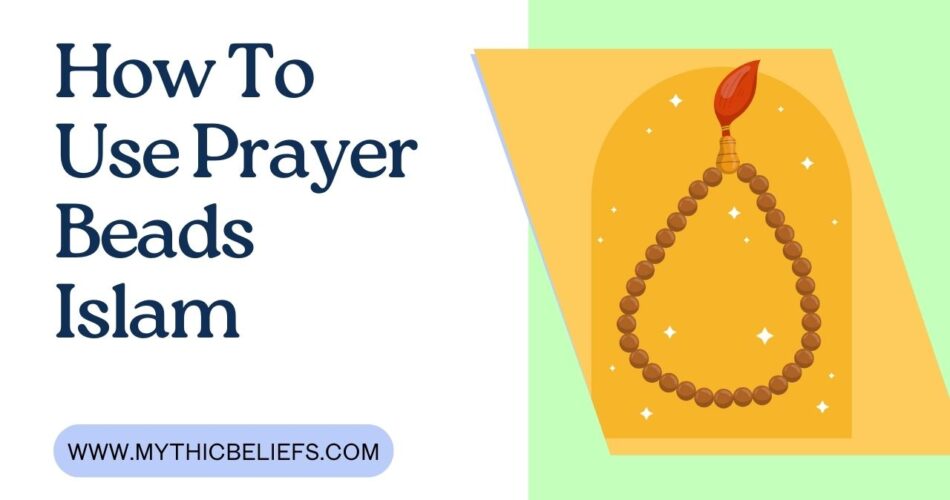Prayer beads in Islam — often called misbaha, tasbih, or subha — are more than just beautiful strands of beads. They’re practical, spiritual, and quietly powerful tools that help keep your heart tethered to remembrance. They’re like tiny anchors of peace in a world that’s constantly rushing, buzzing, and pushing us to the next thing.
I’ve been using prayer beads for years. My first set was a gift from my grandmother, tucked into a little velvet pouch, deep emerald green with golden embroidery. I remember how it felt in my hands — smooth, cool beads clicking softly between my fingers as I tried to keep count during quiet moments. Now, even as life gets more digital, more distracted, I still find solace in this simple, tactile practice. And I’d love to share how you can too.
How Do Muslims Use Prayer Beads?
Muslims use prayer beads to help with dhikr — which simply means remembering God. It’s not a complicated ritual. There are 33 or 99 beads (depending on the set), and each bead marks a repetition of a short phrase. The most common phrases, often recited after each of the five daily prayers, are:
- SubhanAllah (Glory be to God) – 33 times
- Alhamdulillah (Praise be to God) – 33 times
- Allahu Akbar (God is the Greatest) – 34 times
That’s your full 100 if you’re counting.
These phrases might seem small, but trust me — they’re mighty. Saying them slowly, feeling the rhythm of the words, and moving through each bead… it’s like giving your soul a warm cup of tea. It quiets the noise in your head, even if just for a few minutes.
And with everything going on lately — the constant influx of news, AI chatter, and the hustle culture that never quits — there’s something wonderfully grounding about praying with prayer beads in Islam. It’s analog peace in a digital world.
How Do You Activate Prayer Beads?
I get this question more than you’d expect. Do you need to “activate” prayer beads? Like charging a phone? Nope — but I get the sentiment.
There’s no formal ritual to activate them. You don’t need to sprinkle holy water or recite a specific verse over them. But — and here’s where it gets personal — I like to set an intention before I start. Sort of like tuning in.
For me, that looks like sitting in a quiet spot (even if it’s just in my parked car before school pickup), closing my eyes for a second, and taking a deep breath. Then I hold the prayer beads in my hands and whisper a quiet Bismillah (In the name of God). That’s it. Simple. No pressure.
Over time, the beads almost start to feel familiar — like a friend you reach for when your heart’s heavy or your mind’s racing. Some folks even use the same set for years, and the beads become worn smooth from use — I love that. They start to carry a bit of your story.
What Do You Say When Using Prayer Beads in Islam?
This is where it gets beautiful in its simplicity. The most widely practiced phrases are:
- SubhanAllah – for recognizing God’s perfection and majesty. I often say this when I’m walking outside, noticing the sky, trees, or even just the rhythm of my steps.
- Alhamdulillah – to give thanks. I say it after finishing something hard, or when I catch myself complaining too much.
- Allahu Akbar – to remember that God is greater than whatever’s bothering me, even the stubborn to-do list that won’t quit.
There’s also La ilaha illallah (There is no god but God), which is central to the Islamic faith and often repeated during longer sessions of dhikr.
Some people go beyond the structured counts and just keep reciting softly until they feel a sense of stillness or clarity. You can pray with others, or alone. While commuting, walking, or even while doing dishes — there’s no wrong time to remember God.
And recently, I’ve noticed more young Muslims — especially on platforms like TikTok or Instagram Reels — sharing clips of their prayer bead routines, daily dhikr challenges, or even reviewing modern designs of tasbih made with natural stones or eco-friendly materials. It’s heartening to see how tradition is finding its place in modern, everyday life.
Why I Keep Coming Back to My Prayer Beads
Look, life isn’t always calm. My house is often a symphony of kids yelling, phone buzzing, deadlines looming. But having my prayer beads within reach — whether in my coat pocket or tucked into the side of my bag — gives me a tool to reset. It’s like flipping a spiritual switch.
I once had a particularly stressful day — meetings ran late, my coffee spilled (tragically), and everything felt like it was going sideways. I pulled out my prayer beads while waiting for my bus and quietly recited Alhamdulillah. At first, it felt forced. But by the third round, my shoulders relaxed. I remembered I was still breathing. Still blessed. It didn’t fix everything, but it reminded me I wasn’t alone in it.
Conclusion: Try It, Feel It
If you’ve ever been curious about prayer beads in Islam, I say try it. You don’t need to be perfect or even super consistent. Just start. Pick up a set that feels good in your hands. Begin with one phrase. See how it fits into your life.
You might be surprised at how something so simple, so quiet, can shift your day — and your heart.
Have you used prayer beads before? Got a favorite dhikr or moment you’d like to share? Drop it in the comments — I’d love to hear how you make it part of your life.
